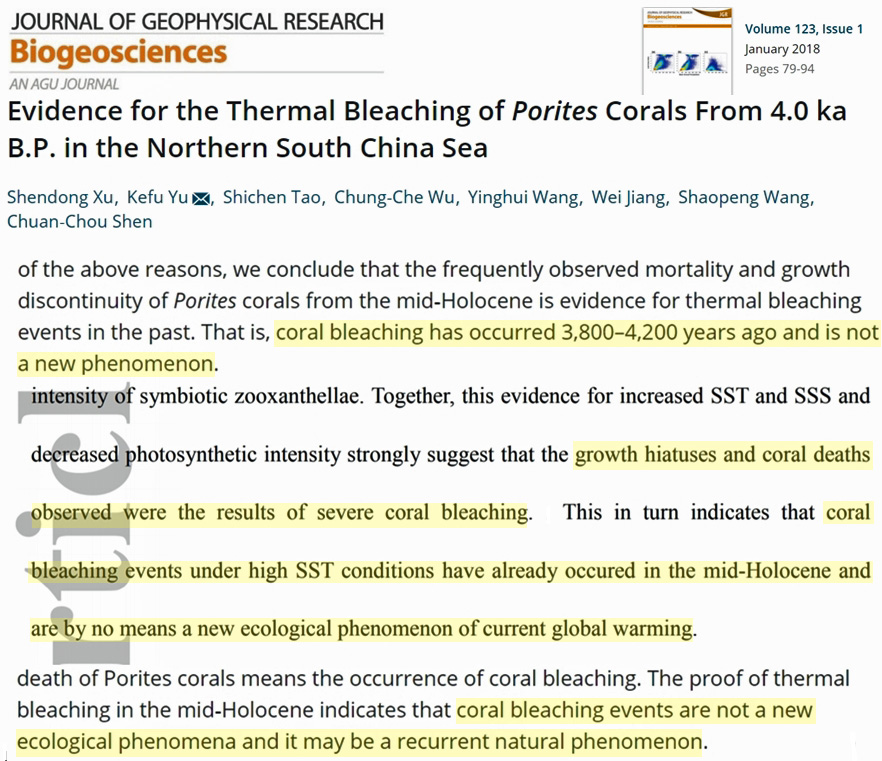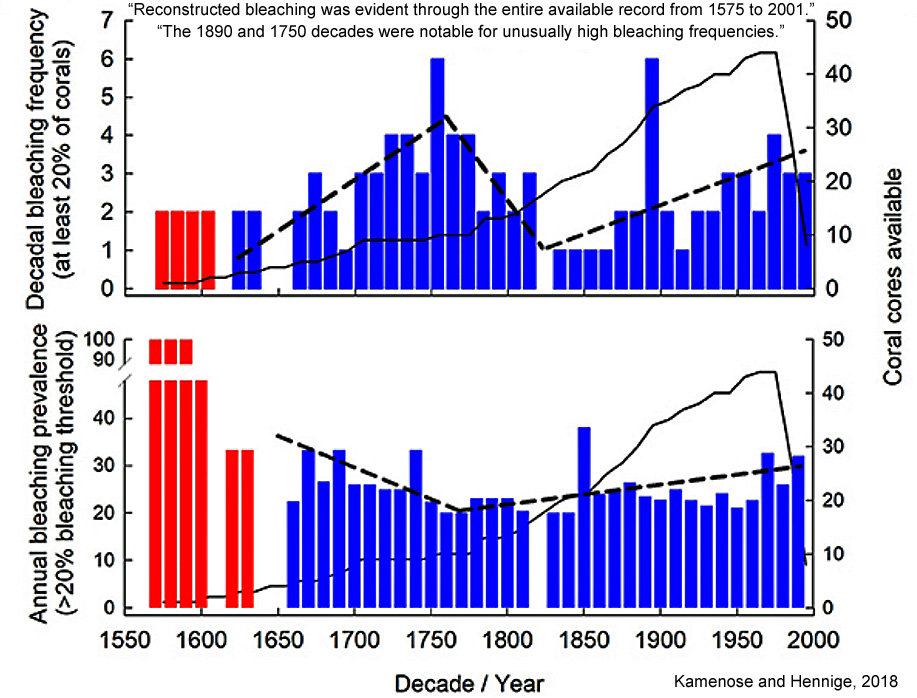2 New Studies Affirm Coral Bleaching Events Are Natural – More Bleaching In 1750s, 1890s Than Today
2 New Studies Affirm Coral Bleaching Events Are Natural – More Bleaching In 1750s, 1890s Than Today
Coral reef bleaching events occur after exposure to unusually warm water temperatures or excessive sunlight. Activists claim that today’s coral bleaching events are not only unprecedented, but reefs will soon disappear. In contrast, scientists have determined that modern-day bleaching events are not unusual or unprecedented, but only a continuation of a naturally-occurring phenomenon.
A few thousand years ago, sea surface temperatures in the South China Sea were at least 2°C warmer than they are today. Mass coral death events routinely occurred due to severe bleaching (Xu et al., 2018).
In more recent centuries, a new study reveals that there were more bleaching events in the 1750s and 1890s — during a period encompassing the Little Ice Age — than there have been in recent decades (Kamenose and Hennige, 2018).
Obviously, corals were able to survive past bleaching events, which are naturally-occurring and “by no means a new ecological phenomenon of current global warming” (Xu et al., 2018).
What Activists Write About ‘Unprecedented’ Coral Bleaching

Image Source: Popular Science

Image Source: Mother Jones
What Newly Published Science Says…
Xu et al., 2018
Evidence for the Thermal Bleaching of Porites Corals
From 4.0 ka B.P. in the Northern South China Sea
“This study provides evidence that thermal coral bleaching events have occurred in the warmer mid-Holocene (where maximum monthly summer SST was 2 °C higher than at present) in Hainan island. … We carried out this pilot study to explore the responses of corals to abnormally warm conditions in prehistoric periods. Four massive Porites coral fossils that died 3800 – 4200 years ago were collected from the Wenchang fringing reef, Hainan Island, NSCS. The reconstructed SST just prior to the mortality surfaces and growth discontinuities were higher than the [modern] maximum summer SSTs in the NSCS [Northern South China Sea]. This indicated that the corals’ deaths and interruptions in growth – which were observed to be in summer – were accompanied by an anomalously high SST [sea surface temperature]. Enhanced Δδ18O suggested increased evaporation and high-SSS conditions, attributable to warm sea surface temperatures.”
“A significant negative shift in δ13C just prior to mortality surfaces and growth discontinuities indicated a reduced photosynthetic intensity of symbiotic zooxanthellae. Together, this evidence for increased SST and SSS and decreased photosynthetic intensity strongly suggest that the growth hiatuses and coral deaths observed were the results of severe coral bleaching. This in turn indicates that coral bleaching events under high SST conditions have already occurred in the mid-Holocene and are by no means a new ecological phenomenon of current global warming.”

Kamenose and Hennige, 2018
Reconstructing Four Centuries of Temperature-Induced
Coral Bleaching on the Great Barrier Reef
“Reconstructed bleaching was evident through the entire available record from 1575 to 2001. To determine any GBR-wide bleaching patterns, corals were pooled from all regions in the GBR spanning 15.13 to 22.23°S. Quantitative assessments of bleaching were conducted between 1620 and 2001 for frequency and 1640–2001 for prevalence. Outside of these periods, while we have documented historic bleaching, it is possible that the number of cores available drove the patterns observed.”
“Reconstructed bleaching frequency demonstrated three trends; (1) frequency increased from 1620 to 1753 ± 31 (years) reaching up to 6 years of each decade showing evidence of bleaching in at least 20% of coral cores. (2) Bleaching frequency decreased to 1820 ± 31 when only 1 year of every decade had evidence of bleaching in at least 20% of coral cores. (3) Bleaching frequency increased again from 1820 ± 31 to 2001. The 1890 and 1750 decades were notable for unusually high bleaching frequencies. In contrast to bleaching frequency, bleaching prevalence only demonstrated two trends; (1) a negative trend from 1640 – 1774 ± 78, with prevalence falling from 41 to 21%. 2) An increase in bleaching prevalence from 21% in 1774 ± 78 to 31 % in 2001.”




